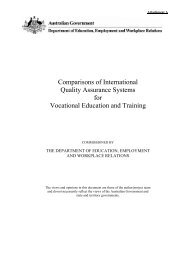Epidemics in a Changing World - Department of Innovation, Industry ...
Epidemics in a Changing World - Department of Innovation, Industry ...
Epidemics in a Changing World - Department of Innovation, Industry ...
Create successful ePaper yourself
Turn your PDF publications into a flip-book with our unique Google optimized e-Paper software.
Decreas<strong>in</strong>g prosperity results <strong>in</strong> pockets <strong>of</strong> regional poverty, particularly <strong>in</strong> urban slums,<br />
which also contribute to the spread <strong>of</strong> <strong>in</strong>fectious diseases. Poor public health <strong>in</strong>frastructure <strong>in</strong><br />
these areas means that disease outbreaks are difficult to control, which then poses a risk to<br />
neighbour<strong>in</strong>g countries.<br />
Furthermore, the importation <strong>of</strong> products from countries with poor sanitary practices has<br />
the potential to spread diseases. The importation <strong>of</strong> buffalo meat from India to Indonesia and<br />
Malaysia, for <strong>in</strong>stance, may lead to the spread <strong>of</strong> foot and mouth disease <strong>in</strong> the region.<br />
EpidemICs <strong>in</strong> a Chang<strong>in</strong>g <strong>World</strong><br />
Report <strong>of</strong> the Expert Work<strong>in</strong>g Group<br />
14<br />
Chang<strong>in</strong>g land use<br />
Due to rapidly <strong>in</strong>creas<strong>in</strong>g human population densities and the demands placed on food<br />
production systems, there have been substantial changes <strong>in</strong> land use <strong>in</strong> Australia and <strong>in</strong> our<br />
region as a whole. The spread <strong>of</strong> many <strong>in</strong>fectious diseases has been l<strong>in</strong>ked to chang<strong>in</strong>g land<br />
use, <strong>in</strong>clud<strong>in</strong>g the build<strong>in</strong>g <strong>of</strong> dams. 50 Further, deforestation and the spread<strong>in</strong>g <strong>of</strong> farms <strong>in</strong>to<br />
areas close to wildlife habitats have resulted <strong>in</strong> greater potential for contact between wild<br />
animals, domestic animals, and humans. 51<br />
For example, fruit bats may feed <strong>in</strong> cultivated areas and thus may <strong>in</strong>directly contam<strong>in</strong>ate animal<br />
and human food and water sources, lead<strong>in</strong>g to <strong>in</strong>fection with Hendra and Nipah viruses. 52<br />
Chang<strong>in</strong>g livestock production technologies<br />
Furthermore, the practice <strong>of</strong> feed<strong>in</strong>g livestock with prote<strong>in</strong> derived from livestock caused the<br />
spread <strong>of</strong> BSE.<br />
Demographic changes<br />
Human and animal populations <strong>in</strong>evitably change <strong>in</strong> composition and location, and these<br />
changes can alter disease emergence, host distribution, exposure risk and spread, and<br />
associated illness and mortality rates. Significant demographic changes can be expected as a<br />
consequence <strong>of</strong> climate change. 53<br />
Drug resistance<br />
When <strong>in</strong>fectious agents are exposed to therapeutics (such as antibiotics or antiviral agents)<br />
or to host antibodies <strong>in</strong>duced by vacc<strong>in</strong>es, evolutionary pressure will select for stra<strong>in</strong>s able<br />
to survive. Of particular concern is sub-optimal use <strong>of</strong> human or animal therapeutic drugs,<br />
<strong>in</strong>creas<strong>in</strong>g the potential for development <strong>of</strong> resistant stra<strong>in</strong>s. For example, feed<strong>in</strong>g low levels<br />
<strong>of</strong> antimicrobial drugs to livestock leads to the development <strong>of</strong> drug-resistant bacteria capable<br />
<strong>of</strong> <strong>in</strong>fect<strong>in</strong>g large numbers <strong>of</strong> animals and therefore to widespread disease outbreaks. The<br />
potential exists also to have antibiotic resistant organisms transferred to humans via food.<br />
Drug resistance has proven to be a particularly significant issue with <strong>in</strong>fections such as<br />
tuberculosis that require long courses <strong>of</strong> drugs. This and some further examples <strong>of</strong> drug<br />
resistance are discussed briefly below.<br />
Tuberculosis resistance<br />
Similarly, the slow progression <strong>of</strong> tuberculosis and the need for long and complicated drug<br />
treatments mean that the risk <strong>of</strong> develop<strong>in</strong>g antibiotic resistant stra<strong>in</strong>s <strong>of</strong> tuberculosis is<br />
real. Many factors contribute to these failures <strong>in</strong>clud<strong>in</strong>g addition <strong>of</strong> a s<strong>in</strong>gle drug to a fail<strong>in</strong>g
















